A linear gradient brush paints an area with a linear gradient. The LinearGradientBrush object represents a linear gradient brush. The default value linear gradient value is diagonal. The StartPoint and EndPoint properties of the LinearGradientBrush represent the start and end points of a gradient. The default values of these properties is (0,0) and (1,1), which is upper-left corner to lower-right corner of an area.
Figure 16 and 17 show a diagonal gradient (MSDN sample).
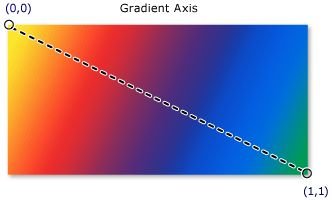
Figure 16. Linear Gradient
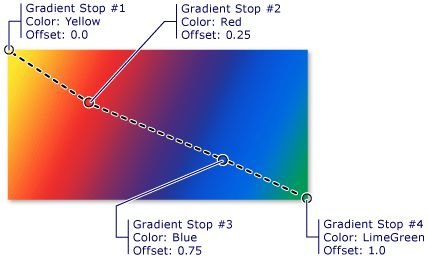
Figure 17. Linear Gradient with Stops
Creating a Linear Gradient Brush
The LinearGradientBrush element in XAML creates a linear gradient brush. The following code snippet creates a linear gradient brush with blue and red colors by setting GradientStops. The StartPoint and EndPoint values are (0,0) and (1,1).
<LinearGradientBrush StartPoint="0,0" EndPoint="1,1" >
<GradientStop Color="Blue" Offset="0" />
<GradientStop Color="Red" Offset="1.0" />
</LinearGradientBrush>
We can fill a shape with a gradient brush by setting a shape's Fill property to the gradient brush. The code snippet in Listing 15 creates a rectangle shape sets the Fill property to a LinearGradientBrush with blue and red colors.
<Rectangle Width="200" Height="100">
<Rectangle.Fill>
<LinearGradientBrush StartPoint="0,0" EndPoint="1,1" >
<GradientStop Color="Blue" Offset="0" />
<GradientStop Color="Red" Offset="1.0" />
</LinearGradientBrush>
</Rectangle.Fill>
</Rectangle>
Listing 15
The output looks like Figure 18.
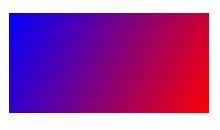
Figure 18. A shape filled with a linear gradient brush
Now let's apply multiple stops with multiple colors. The code snippet in Listing 16 creates a linear gradient brush with five stops.
<Rectangle Width="200" Height="100">
<Rectangle.Fill>
<LinearGradientBrush StartPoint="0,0" EndPoint="1,1" >
<GradientStop Color="Blue" Offset="0.1" />
<GradientStop Color="Orange" Offset="0.25" />
<GradientStop Color="Yellow" Offset="0.50" />
<GradientStop Color="Green" Offset="0.75" />
<GradientStop Color="Red" Offset="1.0" />
</LinearGradientBrush>
</Rectangle.Fill>
</Rectangle>
Listing 16
The new output generated by Listing 16 looks like Figure 19.
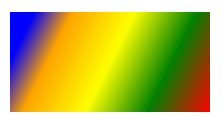
Figure 19. A linear gradient brush with 5 stops
The CreateARectangleWithLGBrush method listed in Listing 17 draws same rectangle in Figure 19 dynamically.
Public Sub CreateARectangleWithLGBrush()
' Create a Rectangle
Dim blueRectangle As New Rectangle()
blueRectangle.Height = 100
blueRectangle.Width = 200
' Create a linear gradient brush with five stops
Dim fiveColorLGB As New LinearGradientBrush()
fiveColorLGB.StartPoint = New Point(0, 0)
fiveColorLGB.EndPoint = New Point(1, 1)
' Create and add Gradient stops
Dim blueGS As New GradientStop()
blueGS.Color = Colors.Blue
blueGS.Offset = 0.0
fiveColorLGB.GradientStops.Add(blueGS)
Dim orangeGS As New GradientStop()
orangeGS.Color = Colors.Orange
orangeGS.Offset = 0.25
fiveColorLGB.GradientStops.Add(orangeGS)
Dim yellowGS As New GradientStop()
yellowGS.Color = Colors.Yellow
yellowGS.Offset = 0.5
fiveColorLGB.GradientStops.Add(yellowGS)
Dim greenGS As New GradientStop()
greenGS.Color = Colors.Green
greenGS.Offset = 0.75
fiveColorLGB.GradientStops.Add(greenGS)
Dim redGS As New GradientStop()
redGS.Color = Colors.Red
redGS.Offset = 1.0
fiveColorLGB.GradientStops.Add(redGS)
' Set Fill property of rectangle
blueRectangle.Fill = fiveColorLGB
' Add Rectangle to the page
LayoutRoot.Children.Add(blueRectangle)
End Sub
Listing 17
By simply changing the StartPoint and EndPoint values, we can generate a vertical gradient shapes. By changing a few lines below in code listed in Listing 17 generates Figure 20.
' Create a linear gradient brush with five stops
Dim fiveColorLGB As New LinearGradientBrush()
fiveColorLGB.StartPoint = New Point(0, 0.5)
fiveColorLGB.EndPoint = New Point(1, 0.5)
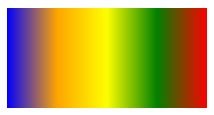
Figure 20. Vertical gradient